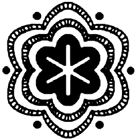 Clicking
on an image will open another window. You can use the second window
to scroll through all the enlarged images associated with this article
Clicking
on an image will open another window. You can use the second window
to scroll through all the enlarged images associated with this article |
The Henna Page Journal |
|
|
[1] Rangoli, also known as Mandana, Alpona and Kolam, are designs executed by women using rice flour, turmeric, spices, flowers, or henna on domestic floors and walls. The designs are auspicious and have ritual significance for the occasion. They purify the domestic space, honor and invite the presence of a deity. In the case of birth patterns, the soul of the child is welcomed with these patterns and directed to the proper place. [2] Bishmillah allahu akbar ‘ala ----In the name of God, God who is Great ---(the name of the child) ben (son) or bent (daughter) – (of so and so) [3] Zgrit: a North African and Middle Eastern loud, shrill celebratory ritual exaltation done by women. The sound is made by loudly singing a high note while flicking the tongue back and forth across the upper front teeth. The Zgrit is intended to frighten away evil spirits. Women in an Amazigh house trill a zgrit seven times at the birth of a son, three times at the birth of a daughter. Hennaing a woman after she gives birth is a traditional way to deter the malevolent spirits that cause disease, depression, and poor bonding with her infant. The action of applying henna to a mother after childbirth, particularly to her feet, keeps her from getting up to resume housework! A woman who has henna paste on her feet must let a friend or relative help her care for older children, tend the baby, cook and clean! This allows her to regain her strength and bond with her new baby. She is also comforted by having friends who care about her well-being, and is helped to feel pretty again. It’s a comfort to have feet beautified when you haven’t seen them for several months. The countries that have these traditions have very low rates of postpartum depression. This paper is illustrated with traditional henna patterns from Morocco and Rajasthan to be applied to a woman’s feet after childbirth.
|
|
|
|||
| [Home] [How] [Why] [What] [Where] [FAQ] [Forum] | |||
